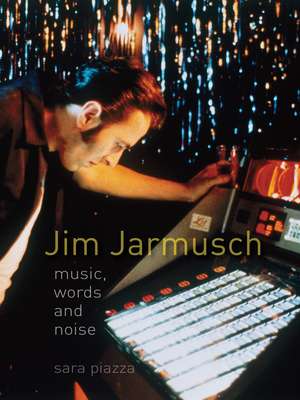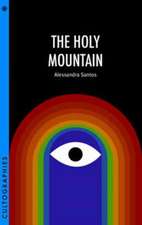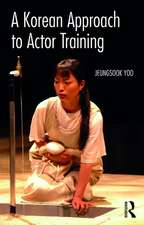Jim Jarmusch: Music, Words and Noise
Autor Sara Piazzaen Limba Engleză Paperback – 14 iul 2015
Jim Jarmusch: Music, Words and Noise is the first book to examine the films of Jim Jarmusch from a sound-oriented perspective. The three essential acoustic elements that structure a film— music, words and noise—propel this book’s fascinating journey through his work. Exploring the director’s extensive back catalogue, including Stranger Than Paradise, Down By Law, Dead Man, and Only Lovers Left Alive, Sara Piazza’s unique reading reveals how Jarmusch created a form of “sound democracy” in film, in which all acoustic layers are capable of infiltrating each other and in which sound is not subordinate to the visual. In his cultural melting pot, hierarchies are irrelevant: Schubert and Japanese noise-bands, Marlowe and Betty Boop, can coexist easily side-by-side. Developing the innovative idea of a “silent-sound film,” Piazza identifies prefiguring elements from pre-sound-era film in Jarmusch’s work.
Highlighting the importance of Jarmusch’s treatment of sound, Piazza investigates how the director’s distinctive reputation consolidated itself over the course of a thirty-year career. Based in New York, Jarmusch was able to develop a fiercely personal vision far from the commercial pressures of Hollywood. The book uses wide-ranging examples from music, film, literature, and visual art, and features interviews with many prominent figures, including Ennio Morricone, Luc Sante, Roberto Benigni, John Lurie, and Jarmusch himself.
An innovative account of a much-admired body of work, Jim Jarmusch will appeal not only to the many fans of the director but all those interested in the connections between sound and film.
Visit the author's page for this book: http://jimjarmusch-musicwordsandnoise.com
Highlighting the importance of Jarmusch’s treatment of sound, Piazza investigates how the director’s distinctive reputation consolidated itself over the course of a thirty-year career. Based in New York, Jarmusch was able to develop a fiercely personal vision far from the commercial pressures of Hollywood. The book uses wide-ranging examples from music, film, literature, and visual art, and features interviews with many prominent figures, including Ennio Morricone, Luc Sante, Roberto Benigni, John Lurie, and Jarmusch himself.
An innovative account of a much-admired body of work, Jim Jarmusch will appeal not only to the many fans of the director but all those interested in the connections between sound and film.
Visit the author's page for this book: http://jimjarmusch-musicwordsandnoise.com
Preț: 208.99 lei
Nou
Puncte Express: 313
Preț estimativ în valută:
39.99€ • 41.84$ • 33.22£
39.99€ • 41.84$ • 33.22£
Carte disponibilă
Livrare economică 12-26 martie
Livrare express 26 februarie-04 martie pentru 42.08 lei
Preluare comenzi: 021 569.72.76
Specificații
ISBN-13: 9781780234410
ISBN-10: 1780234414
Pagini: 320
Ilustrații: 50 color plates, 100 halftones
Dimensiuni: 152 x 197 x 23 mm
Greutate: 0.84 kg
Editura: REAKTION BOOKS
Colecția Reaktion Books
ISBN-10: 1780234414
Pagini: 320
Ilustrații: 50 color plates, 100 halftones
Dimensiuni: 152 x 197 x 23 mm
Greutate: 0.84 kg
Editura: REAKTION BOOKS
Colecția Reaktion Books
Notă biografică
Sara Piazza is an independent writer, radio journalist, documentary film producer, and interpreter based in Berlin.
Cuprins
Introduction
Music
Voices: Amos Poe
1. Flashback: New York Stories
Voices: Phil Kline
2. Jarmusch, the Musician
Voices: John Lurie
3. John Lurie, Gamelan, and Minimal Music
Voices: Marc Ribot
4. Memphis Hip Hop, Mestizos and Samurai
Words
Voices: Masatoshi Nagase
5. The Battle Against Verbocentrism
Voices: Roberto Benigni
6. The Melting Pot of Words, the Way of Cultural Relativism
Voices: Luc Sante
7. Jarmusch, the Poet
Noise
Voices: Eszter Balint
8. Communicating at all Cost: Intelligent Noise
Voices: Taylor Mead
9. Silence
Voices: Ennio Morricone
Voices: Jim Jarmusch
References
Profile of Interviewees
Musical Filmography
Acknowledgements
Photo Acknowledgements
Index
Music
Voices: Amos Poe
1. Flashback: New York Stories
Voices: Phil Kline
2. Jarmusch, the Musician
Voices: John Lurie
3. John Lurie, Gamelan, and Minimal Music
Voices: Marc Ribot
4. Memphis Hip Hop, Mestizos and Samurai
Words
Voices: Masatoshi Nagase
5. The Battle Against Verbocentrism
Voices: Roberto Benigni
6. The Melting Pot of Words, the Way of Cultural Relativism
Voices: Luc Sante
7. Jarmusch, the Poet
Noise
Voices: Eszter Balint
8. Communicating at all Cost: Intelligent Noise
Voices: Taylor Mead
9. Silence
Voices: Ennio Morricone
Voices: Jim Jarmusch
References
Profile of Interviewees
Musical Filmography
Acknowledgements
Photo Acknowledgements
Index
Recenzii
“Piazza’s book is a lengthy and detailed study of Jarmusch that intelligently explores his work in terms of sound and which does draw on a few academic sources. . . . Piazza doesn’t merely analyze how sound functions within his films but argues for the importance of sound in terms of how it structures and permeates them. In focusing on how three sonic aspects work in his films—music, words and noise . . . her analyses on the whole are sophisticated and rich . . . an excellent and highly recommended book, which contains some extremely insightful reflections on Jarmusch’s art.”
“The work is a much-needed—and excellent—addition to the limited number of publications dedicated to a very influential and well respected filmmaker. . . . This book is an essential companion to the cinema, music, and poetry of Jarmusch and is accessible to both devotees of the filmmaker and newcomers to his work. It will be of interest for film scholars and students, cinema and music lovers alike.”
“Sara Piazza has sought to peel away some of the dense layers of Jarmusch’s identity in this intelligently written book that suggests that sound without vision is only half of the big picture.”
“The book serves as an important and compelling model for film criticism/film scholarship that engages with and makes itself legible to non-academic cinephiles. The book balances close readings of Jarmusch’s filmography with historical background and personal interviews. Unlike many single-subject volumes aimed at the general public, Piazza never allows her book to devolve into a simple hagiography (despite her clear affinity for Jarmusch’s work). What she has produced, instead, is a genuine critical history of an important filmmaker, and the shifting, complicated, and rich historical and cultural contexts in which he lived and worked.”
“You’ll come away wanting to see a Jim Jarmusch film if you haven’t seen one, and to put this stuff to the test.”
























